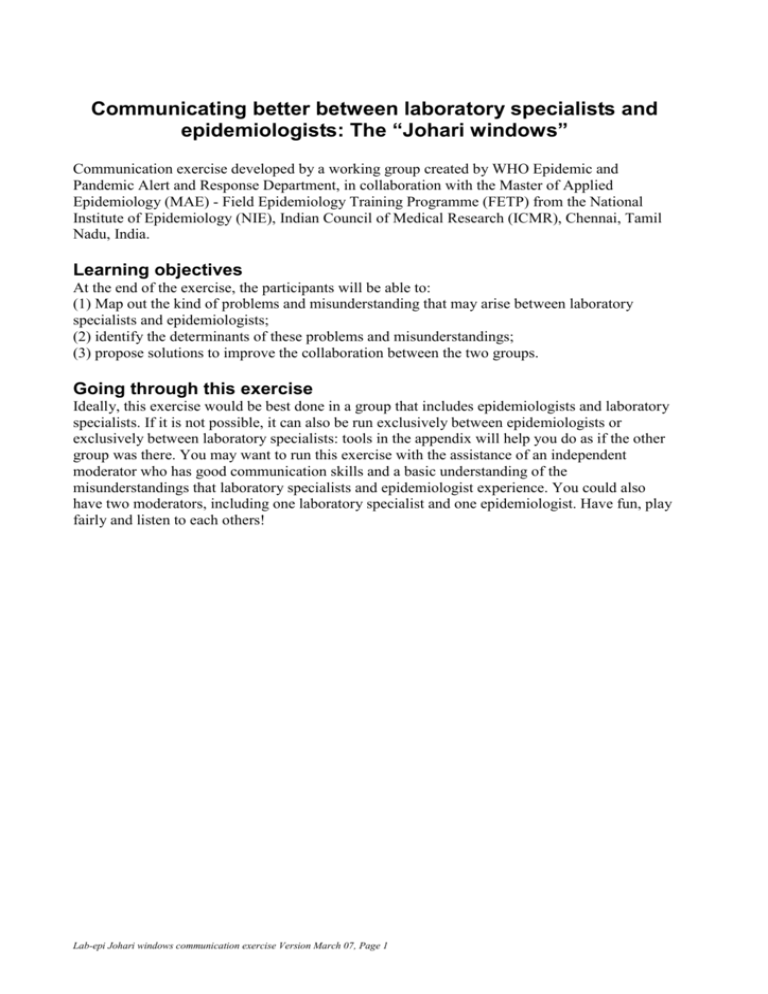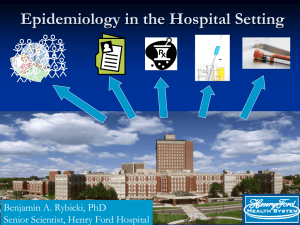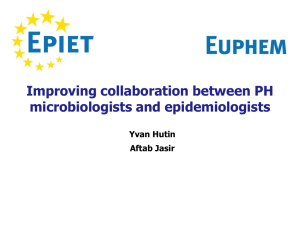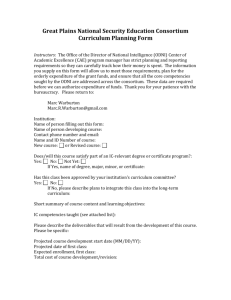Communicating better between laboratory specialists and
advertisement

Communicating better between laboratory specialists and epidemiologists: The “Johari windows” Communication exercise developed by a working group created by WHO Epidemic and Pandemic Alert and Response Department, in collaboration with the Master of Applied Epidemiology (MAE) - Field Epidemiology Training Programme (FETP) from the National Institute of Epidemiology (NIE), Indian Council of Medical Research (ICMR), Chennai, Tamil Nadu, India. Learning objectives At the end of the exercise, the participants will be able to: (1) Map out the kind of problems and misunderstanding that may arise between laboratory specialists and epidemiologists; (2) identify the determinants of these problems and misunderstandings; (3) propose solutions to improve the collaboration between the two groups. Going through this exercise Ideally, this exercise would be best done in a group that includes epidemiologists and laboratory specialists. If it is not possible, it can also be run exclusively between epidemiologists or exclusively between laboratory specialists: tools in the appendix will help you do as if the other group was there. You may want to run this exercise with the assistance of an independent moderator who has good communication skills and a basic understanding of the misunderstandings that laboratory specialists and epidemiologist experience. You could also have two moderators, including one laboratory specialist and one epidemiologist. Have fun, play fairly and listen to each others! Lab-epi Johari windows communication exercise Version March 07, Page 1 Part 1. Identifying problems that may arise in the collaboration between laboratory specialists and epidemiologists Like any professional group, epidemiologists and laboratory specialists have their culture, their way of thinking, their habits and their behaviours. When they talk among themselves, more often than not, they can understand each other because they speak the same language. However, when epidemiologists work with laboratory specialists and vice versa, they may not realize the cultural and communication differences that are there. In some cases, this may lead to a number of misunderstanding and problems. These can become obstacles to effective collaboration and should be overcome. This exercise proposes help to work together better. The objectives of this exercise are to: (1) Map out the kind of problems and misunderstanding that may arise between laboratory specialists and epidemiologists; (2) identify the determinants of these problems and misunderstandings; (3) propose solutions to improve the collaboration between the two groups. This exercise is made of three sections, each of which addresses one of these three objectives. An open, constructive attitude will help making the exercise a harmonious and useful experience. To achieve this objective, we will be using an approach known as the “Johari Windows” in the second step. The “Johari windows” session helps establishing what we know and feel about each other, helps understanding how others see us and helps providing an opportunity to give feedback. On the basis of this disclosure, the next step is making decisions and pledging specific improvements so that we can act as one team. The “Johari Window” is an excellent model to understand the role of self-disclosure and feedback in developing a more open behaviour. It is proposed to use the model to discuss the strengths and weaknesses of the relationship between laboratory specialists and epidemiologists in an open and yet non-threatening way. We will get back to the “Johari windows” – the second step - later, but for now, here is how the first step will work: Epidemiologists and laboratory specialists will be divided in two separate groups; Epidemiologists and laboratory specialists will make an inventory of the kind of difficulties that may come up when epidemiologists and laboratory specialists work together; Epidemiologists will work individually with Table 1 below while laboratory specialists will work individually with Table 2 below. When the individual work is completed, each professional group will get together to make a combined list for (a) epidemiologists and (b) laboratory specialists. As an epidemiologist, you may have worked with laboratory specialists. You may also have experienced difficulties. Could you describe what these were in the box below? Start making a list on your own, sorting out these difficulties by categories. Then, compare it with your epidemiologists colleagues and come up with a consolidated list to share with laboratory specialists later. You may want to do this in a way that remains general and does not point directly at specific institutions and / or individuals. The first line of the table is an example. Lab-epi Johari windows communication exercise Version March 07, Page 2 Table 1: Practical difficulties identified by epidemiologists Organizational / structural difficulties We are not supplied with transport media at the district level Technical difficulties There has been errors in the results reported by the laboratory Communication difficulties The laboratory is not clear in the guidance they give us for sample collection As a laboratory specialist, you may have worked with epidemiologists. You may also have experienced difficulties. Could you describe what these were in the box below? Start making a list on your own, sorting out these difficulties by categories. Then, compare it with your laboratory specialist colleagues and come up with a consolidated list to share with epidemiologists later. You may want to do this in a way that remains general and does not point directly at specific institutions and / or individuals. The first line of the table is an example. Table 2: Practical difficulties identified by laboratory specialists Organizational / structural difficulties Samples reach the laboratory too late Technical difficulties Communication difficulties The samples we received are of We received rectal swabs one poor quality day without knowing that there was a suspicion of cholera during a large outbreak. Lab-epi Johari windows communication exercise Version March 07, Page 3 Part 2. Trying to understand the causes of the difficulties in the collaboration between laboratory specialists and epidemiologists Thank you for filling Table 1 and Table 2. Please sit down between epidemiologists and laboratory specialists to share and exchange these results. You can briefly comment them together before going to the next stage: the “Johari windows” exercise. If you did not have a group from the other side participating, you can review the production that came from similar exercise in the Table 7 and Table 8 in the Appendix 1. Filling the “Johari windows” There are four “Johari windows”. Horizontally, we first have the rows of "things known to others" (above) and then the row of "things not known to others" (below). These are broken down in two columns of the "Things known to us" (left) and the "things not known to us" (right). “The others” in this case means epidemiologists if you are a laboratory specialist and it means epidemiologists if you are a laboratory specialist (and vice versa for the meaning of “us”). The four windows are: Window 1 Area of free activity i.e. those issues that you know and that the others also know. For example: “We epidemiologists think that laboratory specialists can help us confirm a diagnosis and help us identify things that are unknown.” Window 2 Blind area, i.e. those issues or beliefs that we believe "others" hold about us. For example: “Laboratory specialists believe that we, epidemiologists, only focus on numbers.” Window 3 Avoided or hidden area, i.e., your thoughts about the "others" that you find it difficult to say openly. For example: “Laboratory specialists underestimate the importance of epidemiological evidence”. Window 4 Area of unknown activity: questions that we have about which possibly neither the epidemiologists nor the laboratory specialists know the answers. For example: “Maybe we could work together better if we learned each other’s tricks.” Please start filling the four “Johari windows” on your own. Then, compare it with your colleagues and come up with a consolidated list to share with the other group later. Lab-epi Johari windows communication exercise Version March 07, Page 4 Table 3: The “Johari windows” of the epidemiologists. Not known to laboratory specialists Known to laboratory specialists Known to epidemiologists Window 1. Not known to epidemiologists Window 2. (AREA OF FREE ACTIVITY) (BLIND AREA) As epidemiologists, we share these views about laboratory specialists and we are open about it. We believe laboratory specialists hold these views and opinions about epidemiologists but that they have a hard time saying it. Window 3. Window 4. (AVOIDED OR HIDDEN AREA) (AREA OF UNKNOWN ACTIVITY) This is what we really think of laboratory specialists (but find it difficult to say!) Questions that we have? Table 4: The “Johari windows” of the laboratory specialists Not known to epidemiologists Known to epidemiologists Known to laboratory specialists Window 1. Not known to laboratory specialists Window 2. (AREA OF FREE ACTIVITY) (BLIND AREA) As epidemiologists, we share these views about laboratory specialists and we are open about it. We believe epidemiologists hold these views and opinions about laboratory specialists but they have a hard time saying it Window 3. Window 4. (AVOIDED OR HIDDEN AREA) This is what we really think of epidemiologists (but find it difficult to say!) Lab-epi Johari windows communication exercise Version March 07, Page 5 (AREA OF UNKNOWN ACTIVITY) Questions that we have? Table 5: Content of the “Johari windows” I am a: 1. Epidemiologist 2. Laboratory specialist And this is how I fill my “Johari windows”: Window 1 (Free activity) As ____________, we share these views about _________ and we are open about it: Window 2 (The blind spot) We believe ____________ hold these views and opinions about us but they have a hard time saying it: Window 3 (The hidden) This is what we really think of ___________ (but find it difficult to say!): Window 4 (The unknown) There are questions we have about the way we relate with ___________ Lab-epi Johari windows communication exercise Version March 07, Page 6 Part 3. Using the better understanding we have of each other to facilitate collaboration Getting to understand each other through increasing the size of the first window (the free activity) We will now go through a process by which each group will share their window 1 and 4 and disclose to the other the windows 2 and 3. Through this process, the window 1 – what we all share-will get bigger and may help in addressing some of the problems identified in the Table 1and Table 2. To proceed: In your small group, prepare a summary of your four windows (either on a flip board chart or on a PowerPoint); Report your summary back to the plenary session. (If you did not have epidemiologists or laboratory specialists in your group, of if you want to generate more ideas, you can review what some epidemiologists and laboratory specialists have produced in similar exercises (Appendix 2 and Appendix 3) Combine all the answers in a large chart – or in a Power Point presentation. Don’t forget to praise the positive content of window 1: It is what is already acquired. An interesting game is to look for matches between the window 2 of one group and the window 3 of the other (and vice versa): You may see that in some cases, one group may be already somewhat conscious of what the other group think. But that is not always true and rarely expressed. Using the better understanding to propose better practices Now, it is proposed that epidemiologists and laboratory specialists work together as a group to get back to the problems identified in the Table 1and Table 2 so that solutions can be found. You can use the framework proposed in Table 6. In the first column, you can put back together all the practical problems identified. In the second, write the cause of these problems that you identified in light of the “Johari windows” exercise. In the third, propose recommendations so that this problem is fixed. Once you have reviewed the results of you own working group, you can check out a template framework (Appendix 4). Table 6: Framework to propose recommendations to improve the collaboration between epidemiologists and laboratory specialists. Type of difficulty Causes identified through the “Johari windows” exercise Proposed recommendations Organizational / structural difficulties Technical difficulties Communication difficulties - Lab-epi Johari windows communication exercise Version March 07, Page 7 Conclusion The “Johari windows” exercise can help various groups increase their first window and be more open about problems. This translates into more trust and better collaboration if a plan of action is put in place after the exercise. In addition, and beyond the mere issue of effectiveness, certain attitudes of mutual respect and understanding will always gain from efforts so that the collaboration can become a more pleasant experience. That is the challenge for each of us when we go back to work after this game. Lab-epi Johari windows communication exercise Version March 07, Page 8 Appendix 1: Practical difficulties experienced by epidemiologists and laboratory specialists Table 7: Practical difficulties identified by epidemiologists Organizational / structural difficulties Delays in reporting results Some laboratories do not work at weekends Technical difficulties Samples are never good enough Lab specialists are often dependant on clinical symptoms; they may have only limited experience in testing asymptomatic individuals Epidemiologists often just want a negative or positive result - nothing in between Communication difficulties Difficulties in interpreting tests results Difficulties in obtaining straight answers Lab specialists have difficulties releasing their results/legal issues about sharing their information Table 8: Practical difficulties identified by laboratory specialists Organizational / structural difficulties Samples sent with insufficient information on the patients/context Epidemiologists want results very fast which is sometimes not feasible Technical difficulties Samples not packed safely Bad quality samples Labels not legible Wrong transport medium Epidemiologists have difficulty in interpreting results Communication difficulties Delayed laboratory involvement Arrival of samples is not announced in good time Collaboration sought without full engagement of the laboratory Pressure for unrealistic black or white answer Lack of engagement of the laboratory to interpret results Final report not sent once the investigation is over Lab-epi Johari windows communication exercise Version March 07, Page 9 Appendix 2: The “Johari windows” of the epidemiologists The free activity (window 1) Laboratory specialists can help us confirm a diagnosis and help us identify things that are unknown . Laboratory specialists can provide us the last bit of evidence. Co-operation between epidemiologists and laboratory specialists is necessary for the effective control of infectious diseases Getting a good collaboration between laboratory specialists and epidemiologists require early partnership, efforts, mutual understanding and communication in the professional and personal aspects. Both groups believe infectious diseases are important. Laboratory specialists and epidemiologists are professionals in their own fields and have complementary skills. The blind spot (window 2) Laboratory specialists think: We focus on numbers. We overestimate our understanding of laboratory issues. We are bad at keeping them informed We can’t engage them early enough. We use them and we don’t fully engage them in investigations. We care more about statistics than about the patient. It is easy to be an epidemiologist. Epidemiology is not important. We can’t generate credible evidence. We can’t understand the details of their investigations. We are unable to collect a good sample (while in fact, it is difficult). We are too academic and not enough practical. We can’t understand infectious diseases because we don’t work with the pathogens. The hidden / avoided (window 3) Laboratory specialists: Underestimate the importance of epidemiological evidence. Have a hard time seeing the case-patient behind the sample. Get lost in details, miss the big picture and can’t think in terms of populations. Think in terms of research and don’t think in terms of public health. Like theirs tests but are not always aware of their sensitivity and specificity. Have a hard time giving a straight, easy answer and communicating their work in a simple way. Produce results that should be discarded if they don’t fit with the epidemiological evidence. Are more accepted by society then epidemiologists and are perceived as being more necessary. Earn more than epidemiologists and have an accepted degree. The unknown (window 4) Maybe we could work together better if we learned each other’s tricks. Lab-epi Johari windows communication exercise Version March 07, Page 10 Appendix 3: The “Johari windows” of the laboratory specialists The free activity (window 1) Outbreak investigations require laboratory confirmation. Laboratory specialists have fewer opportunities to go to the field. Laboratory specialists and epidemiologists can learn from each other. Epidemiologists are skilled. Epidemiologists are good to have a big picture and to define global strategies as they deal with figures. Laboratory specialists have a technical role on individual analyses. Laboratory specialists do strange things we don’t always understand. Share a similar concern about ill people. Share the same interest in the epidemiological context and outcome The blind spot (window 2) Epidemiologists think: Microbiology is not essential to generate evidence. We can’t understand surveillance and epidemiology. We don’t care about public health. We can’t talk in terms of statistical significance. We are incompetent if we can’t give a simple answer. We lack global vision. We make things unnecessarily difficult. We only work in the laboratory (this is not true). We earn too much (this is also not true). We can be given a secondary role. We are technical and not skilled for complex analyses. We are too rigid with our time. We have a personal relationship with our microbes. We are here to confirm their results We have no role in the interpretation of the data to yield conclusions. We cannot be trusted. We speak our own language. The hidden / avoided (window 3) Epidemiologists: Rely too much on their methods and don’t think laboratory confirmation is really needed. Are not good at communicating with us. Feel they are superior because they deal with humans while we deal with tubes. Use us as tools, and that does not lead us to be open about the results. Involve the laboratory only for outbreaks and too late. Do not give us all the information (claiming confidentiality) or inform us about outcomes of their work. Get frustrated with delays. Lack critical judgment on laboratory issues because they don’t understand quality criteria (e.g., sensitivity, specificity). Steal our results, only use us as service and not as equal partners. Don’t understand the complexity and the subjectivity of what we do and want black or white answers. Don’t appreciate our constraints (e.g., time, equipment), our difficulties and our realities. Travel with computers to fill time-consuming databases. Lab-epi Johari windows communication exercise Version March 07, Page 11 Want to manage everything without any knowledge of laboratory issues. Ask basic microbiology questions about things they should know. Are not scientific enough. Talk, elaborate, assume, estimate, discuss and interpret but don’t deal with real data the way we do. Are often arrogant MDs who underestimate laboratory specialists who are often not MDs. Don’t keep us informed. The unknown (window 4) We could do better surveillance if epidemiologists were to explain surveillance to us. Lab-epi Johari windows communication exercise Version March 07, Page 12 Organizational / structural difficulties Appendix 4: Framework to identify problems, review causes and propose recommendations in the collaboration between epidemiologists and laboratory specialists Type of difficulty Causes identified through the “Johari windows” exercise Proposed recommendations Technical difficulties Delays in reporting results Epidemiologists don’t understand how patient information helps guiding laboratory testing Laboratory specialists may not communicate how patient information guide their testing. Epidemiologists may be unaware of the complexity of some analyses. Epidemiologists may be unaware of the time it takes to obtain certain results. Communication difficulties Samples sent with insufficient information on the patient Bad quality samples Samples not packed safely Difficulties in interpreting tests results Difficulties in obtaining straight answer Pressure for unrealistic black or white answer Delayed laboratory involvement Collaboration sought without full engagement of the laboratory Lack of engagement of the laboratory to interpret results Final report not sent once the investigation is over Epidemiologists may be unaware of sampling procedures. Laboratory specialists may not communicate the sampling procedure. Epidemiologists may be unaware of packaging and transport procedures. Laboratory specialists may not communicate the packaging and transport procedure. Epidemiologists may be unaware of the complexity and limitations of the tests used. Laboratory specialists may not communicate clearly the complexity and limitations of the test used. Disseminate guidance for the packaging and transport of samples to epidemiologists. Epidemiologists must become familiar with testing procedures, their complexity and their limitations. Laboratory specialists must communicate clearly and simply the test procedures, their complexity and their limitations. Epidemiologists just use the laboratory to confirm a hypothesis. Epidemiologists do not realize the benefit of high quality collaboration with the laboratory. Epidemiologists don’t take laboratory specialists as full fledge partners in an investigation. Lab-epi Johari windows communication exercise Version March 07, Page 13 Epidemiologists must learn how patient information helps guiding laboratory testing. Laboratory specialists must communicate how patient information guides their testing. Epidemiologists must become familiar with laboratory procedures. Epidemiologists must enquire about the time needed to obtain results. Laboratory specialists need to understand why epidemiologists may require rapid results Disseminate guidance to collect appropriate samples to epidemiologists. Epidemiologists must learn from examples to understand the benefit of high quality collaboration with the laboratory. Build trust through engaging in full collaboration with regular communication.








